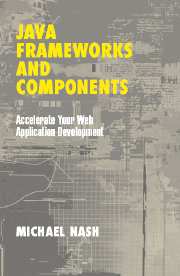Book contents
- Frontmatter
- Contents
- Acknowledgments
- 1 Components and Application Frameworks
- 2 Components: The Future of Web-Application Development
- 3 Application Frameworks: What Do They Provide and What Are the Benefits?
- 4 Choosing an Application Framework
- 5 A Catalog of Application Frameworks
- 6 Comparing Frameworks
- 7 Open Source and Components/Frameworks
- 8 Development Methodologies and Design Patterns
- 9 Integrated Development Environments
- 10 Strategies for Using Frameworks: Best Practices
- 11 Conclusions: The Future of Frameworks and Components
- Appendix: Case Studies
- Glossary
- Index
4 - Choosing an Application Framework
Published online by Cambridge University Press: 28 July 2009
- Frontmatter
- Contents
- Acknowledgments
- 1 Components and Application Frameworks
- 2 Components: The Future of Web-Application Development
- 3 Application Frameworks: What Do They Provide and What Are the Benefits?
- 4 Choosing an Application Framework
- 5 A Catalog of Application Frameworks
- 6 Comparing Frameworks
- 7 Open Source and Components/Frameworks
- 8 Development Methodologies and Design Patterns
- 9 Integrated Development Environments
- 10 Strategies for Using Frameworks: Best Practices
- 11 Conclusions: The Future of Frameworks and Components
- Appendix: Case Studies
- Glossary
- Index
Summary
In this chapter, we look at the differentiating factors of frameworks, and give you a set of techniques for choosing frameworks. We also look at how you can determine whether a particular framework fits your needs. We concentrate on the practical job of choosing the right pieces to get the job done, and give you the information you need to choose the right tool.
OVERVIEW
Let us say that you are convinced that the benefits of frameworks are real, and that it would make good business sense for you and your organization to adopt an appropriate framework. Now what? Where do you go to find frameworks, and how do you go about evaluating them? When you first start evaluating frameworks, there are some high-level observations you can make right away. Let us examine them first and then get into more details.
Identification
There is sometimes a fine line between a component library and an application framework. Some products are oriented more toward providing a set of application elements, rather than providing the backbone to build an entire application. Often, component libraries are more focused, concentrating on a particular area of the application, such as file access, visual presentation, or middle-ware elements. In general, a component library is defined as a collection of fully-developed components, and may include capabilities for generating your own components.
Information
- Type
- Chapter
- Information
- Java Frameworks and ComponentsAccelerate Your Web Application Development, pp. 105 - 130Publisher: Cambridge University PressPrint publication year: 2003
